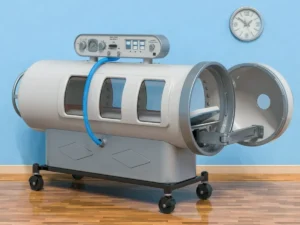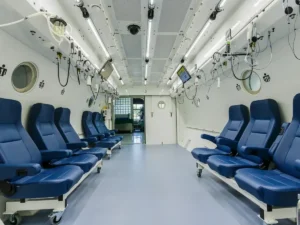Atmospheric pressure
The basic difference between the atmosphere in a normobaric chamber and the atmosphere of the Earth is the atmospheric pressure. In normobaric chambers, the pressure is up to 1.5 ATA (technical atmosphere), which means that it is higher than the pressure at sea level on Earth (1 ATA). Increased pressure allows for better oxygen saturation of the blood, which translates into beneficial therapeutic effects.
Oxygen concentration
Another important parameter that distinguishes the atmosphere in a normobaric chamber from the Earth’s atmosphere is the concentration of oxygen. In normobaric chambers, the oxygen concentration is maintained at 34%-40%, while in the Earth’s atmosphere it is around 21%. Higher oxygen concentration promotes better tissue oxygenation, which can accelerate regeneration processes and the treatment of some diseases.
Carbon dioxide concentration
In normobaric chambers, the concentration of carbon dioxide ranges from 1.5% to even 3.2%, which is a much higher value than in the Earth’s atmosphere (0.04%). The latest research recommends maintaining the concentration of carbon dioxide at 3.2%, which is 100 times higher than in the Earth’s atmosphere . The Bohr effect is used here, which is that at a higher concentration of carbon dioxide, hemoglobin releases oxygen more easily to the tissues. In practice, this means that normobaric chambers can adjust the level of carbon dioxide depending on the number of people in the chamber (from 1.5% for one person to 2.5% for two people).
The atmosphere in a normobaric chamber differs from the Earth’s atmosphere in terms of atmospheric pressure, oxygen concentration, and carbon dioxide concentration. Higher pressure, higher oxygen content, and controlled carbon dioxide concentration contribute to better oxygenation of the body, which can have beneficial therapeutic effects.






